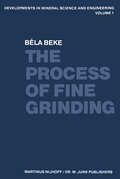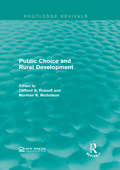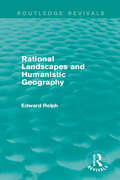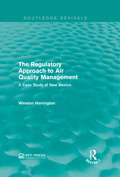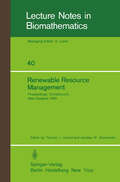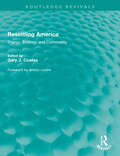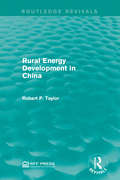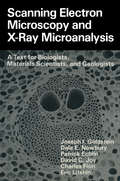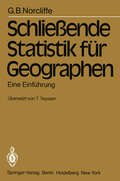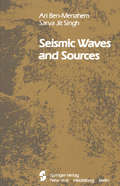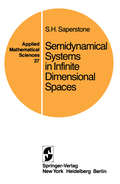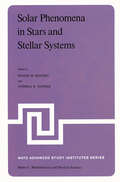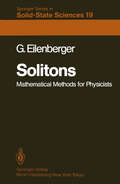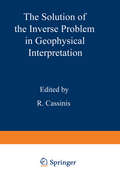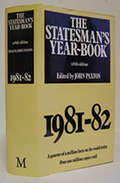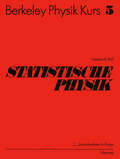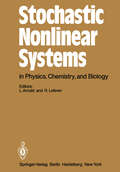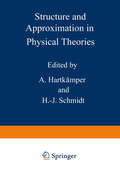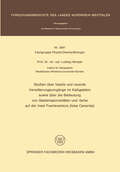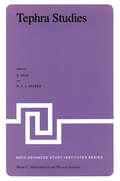- Table View
- List View
The Process of Fine Grinding (Developments in Mineral Science and Engineering #1)
by B. Beke2Vlanuals of mineral dressing or more precisely those of comminution-classifi cation treat in particular the mechanics of the machines, and generally their handling. In this way the plant engineer becomes acquainted with the equip ment but is given no help in learning something of the processes taking place in the material to be comminuted even though the purpose of the operation is to enhance wanted and to avoid unwanted physical or physico-chemical processes. Neglecting the description or representation of generally used and well known equipment the object of this monograph is to supply information on the processes taking place in grinding installations. It explains the sometimes complicated phemonena by applying quite simple means; it requires only an elementary knowledge of mathematics, mechanics and physical chemistry. The ideas are applicable to the grinding of all brittle raw materials or semi finished industrial products. The special problems of cement grinding and thm;e of hall mills are explained in more detail; in cement grinding we have to meet special requirements with regard to ball mills apart from other con siderations -, since these now demand the greatest overall energy consumption. Currently disputed problems are dealt with, and naturally the views of the author are given in detail, but contrary views are also mentioned and the ample list of references ensures that these opposing views can be considered.
Public Choice and Rural Development (Routledge Revivals)
by Clifford S. Russell Norman K. NicholsonThis title, originally published in 1981, explores the difficult, and at times volatile, relationship between public choice and rural development in developing countries. The book is organised into three major sections: the first section examines important general themes, the second describes how public choice and rural development intertwine in some areas of concern to aid donors, and finally, the third section revisits the major themes discussed in the book and offers further understanding to the critical questions and problems at hand. It is a valuable resource for students interested in environmental studies and development studies.
Public Choice and Rural Development (Routledge Revivals)
by Clifford S. Russell Norman K. NicholsonThis title, originally published in 1981, explores the difficult, and at times volatile, relationship between public choice and rural development in developing countries. The book is organised into three major sections: the first section examines important general themes, the second describes how public choice and rural development intertwine in some areas of concern to aid donors, and finally, the third section revisits the major themes discussed in the book and offers further understanding to the critical questions and problems at hand. It is a valuable resource for students interested in environmental studies and development studies.
Rational Landscapes and Humanistic Geography (Routledge Revivals)
by Edward RelphThis book, first published in 1981, explores why it is that the modern built environment, while successfully providing material comfort and technical efficiency, none the less breeds despair and depression rather than inspires hope and commitment. The source of this paradox, where material benefits appear to have been gained only at the expense of intangible values and qualities is found in humanism, the persistent and powerful belief that all problems can be solved through the use of human reason. But humanism has become increasingly confused, rationalistic, callously devoted to efficiency, and authoritarian. These confusions and contradictions, together with the anti-nature stance of humanism and its failure to teach humane behaviour, lead the author to conclude that humanism is best rejected. Such rejection does not advocate the inhuman and anti-human, but requires instead a return to the ‘humility’ that lies at the origin of humanism – a respect for objects, creatures, environments and people. This ‘environmental humility’ is explored in the context of individuality of settings, ways of seeing landscapes, appropriation and ways of building places. This title will be of interest to students of human geography.
Rational Landscapes and Humanistic Geography (Routledge Revivals)
by Edward RelphThis book, first published in 1981, explores why it is that the modern built environment, while successfully providing material comfort and technical efficiency, none the less breeds despair and depression rather than inspires hope and commitment. The source of this paradox, where material benefits appear to have been gained only at the expense of intangible values and qualities is found in humanism, the persistent and powerful belief that all problems can be solved through the use of human reason. But humanism has become increasingly confused, rationalistic, callously devoted to efficiency, and authoritarian. These confusions and contradictions, together with the anti-nature stance of humanism and its failure to teach humane behaviour, lead the author to conclude that humanism is best rejected. Such rejection does not advocate the inhuman and anti-human, but requires instead a return to the ‘humility’ that lies at the origin of humanism – a respect for objects, creatures, environments and people. This ‘environmental humility’ is explored in the context of individuality of settings, ways of seeing landscapes, appropriation and ways of building places. This title will be of interest to students of human geography.
The Regulatory Approach to Air Quality Management: A Case Study of New Mexico (Routledge Revivals)
by Winston HarringtonIn the wake of the Clean Air Amendments of 1970 in the United States, sources of emissions could be held accountable for the degradation of air quality in the local environment. This case study of air quality management in New Mexico was produced to shed some light on the procedures and activities used by agencies in order to control air quality. Originally published in 1981, Winston Harrington uses New Mexico as a case study for its largely centralised control system in Santa Fe to explore the behaviour of air quality agencies and pollution sources and comments on policy implications from this study’s conclusions. This title will be of interest to students of environmental studies and policy makers.
The Regulatory Approach to Air Quality Management: A Case Study of New Mexico (Routledge Revivals)
by Winston HarringtonIn the wake of the Clean Air Amendments of 1970 in the United States, sources of emissions could be held accountable for the degradation of air quality in the local environment. This case study of air quality management in New Mexico was produced to shed some light on the procedures and activities used by agencies in order to control air quality. Originally published in 1981, Winston Harrington uses New Mexico as a case study for its largely centralised control system in Santa Fe to explore the behaviour of air quality agencies and pollution sources and comments on policy implications from this study’s conclusions. This title will be of interest to students of environmental studies and policy makers.
Renewable Resource Management: Proceedings of a Workshop on Control Theory Applied to Renewable Resource Management and Ecology Held in Christchurch, New Zealand January 7 – 11, 1980 (Lecture Notes in Biomathematics #40)
by Thomas L. Vincent Janislaw M. SkowronskiAs society becomes stressed by economic and population pressures, in turn, nature's renewable resources become stressed by harvesting pressures. For our own survival and euphoria, it is paramount that such resources remain as their name implies and not be driven to extinction through short term programs of over exploitation. Consideration of the harvesting of renewable resources leads to a simple question that was the theme of the workshop and is the focus of these proceedings: SUPPoRe you are assigned the role of manager for a specific renewable resource eco system. How would you decide on harvesting policies so that the system can be exploited economically yet at the same time maintain the integrity of the system? This, of course, is a loaded question. First of all, it is not clear that there is ever anyone single decision maker who is able to set the rules for all of the harvesters in an exploited ecosystem. The political process is complicated and to some extent unpredictable. This aspect of the question is recognized to be important, but could not be addressed here. Assuming then that someone really is in charge, what would be involved in the * decision making process? As Clark points out, "there is no alternative but first to model the system. " We agree. However, if the original question was loaded, modeling is the adulterate.
Resettling America: Energy, Ecology and Community (Routledge Revivals)
Every movement has its bellweathers, the ideas that lead the way and rally its adherents towards a set of shared values and visions. Resettling America was one such beacon – a publication for its time and ahead of its time. Those of us doing the work of sustainability and the transformation of communities feel grateful for Gary’s early and prescient contribution that has shaped the thinking of so many around the US and beyond. Essential reading for all green warriors! Jason F. McLennan, Chief Sustainability Officer – Perkins & Will. Founder, Living Building Challenge. Originally published in 1981 and now reissued with a new Preface by Gary J. Coates, Resettling America was one of the first comprehensive, transdisciplinary books on the crisis of sustainability and the implications of that crisis for the re-design of buildings, towns, cities and regions. Through essays by Coates, which provide a theory of ecological design, and case studies written by leading authors and activists of the time, the book presents a strategic vision of how it would be possible to create a sustainable and livable society through a process of cooperative community development rooted in a radical re-visioning of nature, self and society. By providing a strategic vision, as well offering practical means for creating a sustainable society worth sustaining, Resettling America remains more relevant and inspiring than ever to those who face the ecology of crises that now surround us in the 21st Century.
Resettling America: Energy, Ecology and Community (Routledge Revivals)
by Gary J. CoatesEvery movement has its bellweathers, the ideas that lead the way and rally its adherents towards a set of shared values and visions. Resettling America was one such beacon – a publication for its time and ahead of its time. Those of us doing the work of sustainability and the transformation of communities feel grateful for Gary’s early and prescient contribution that has shaped the thinking of so many around the US and beyond. Essential reading for all green warriors! Jason F. McLennan, Chief Sustainability Officer – Perkins & Will. Founder, Living Building Challenge. Originally published in 1981 and now reissued with a new Preface by Gary J. Coates, Resettling America was one of the first comprehensive, transdisciplinary books on the crisis of sustainability and the implications of that crisis for the re-design of buildings, towns, cities and regions. Through essays by Coates, which provide a theory of ecological design, and case studies written by leading authors and activists of the time, the book presents a strategic vision of how it would be possible to create a sustainable and livable society through a process of cooperative community development rooted in a radical re-visioning of nature, self and society. By providing a strategic vision, as well offering practical means for creating a sustainable society worth sustaining, Resettling America remains more relevant and inspiring than ever to those who face the ecology of crises that now surround us in the 21st Century.
Rural Energy Development in China (Routledge Revivals)
by Robert P. TaylorIn this title, originally published in 1981, author Robert P. Taylor calls for a greater understanding of rural energy supply and consumption patterns in the developing countries. Here, Taylor specifically examines the rural energy development in China as it is the world’s largest developing country in terms of population, and it has encountered many of the rural energy problems common in other developing countries. This study provides an analysis of China’s rural energy economy from before 1949 to a general discussion of achievements in rural energy development and the rural energy economy in 1981. This is an ideal title for students interested in environmental studies and development studies.
Rural Energy Development in China (Routledge Revivals)
by Robert P. TaylorIn this title, originally published in 1981, author Robert P. Taylor calls for a greater understanding of rural energy supply and consumption patterns in the developing countries. Here, Taylor specifically examines the rural energy development in China as it is the world’s largest developing country in terms of population, and it has encountered many of the rural energy problems common in other developing countries. This study provides an analysis of China’s rural energy economy from before 1949 to a general discussion of achievements in rural energy development and the rural energy economy in 1981. This is an ideal title for students interested in environmental studies and development studies.
Scanning Electron Microscopy and X-Ray Microanalysis: A Text for Biologists, Materials Scientists, and Geologists
by Joseph Goldstein Dale E. Newbury Patrick Echlin David C. Joy Charles Fiori Eric LifshinThis book has evolved by processes of selection and expansion from its predecessor, Practical Scanning Electron Microscopy (PSEM), published by Plenum Press in 1975. The interaction of the authors with students at the Short Course on Scanning Electron Microscopy and X-Ray Microanalysis held annually at Lehigh University has helped greatly in developing this textbook. The material has been chosen to provide a student with a general introduction to the techniques of scanning electron microscopy and x-ray microanalysis suitable for application in such fields as biology, geology, solid state physics, and materials science. Following the format of PSEM, this book gives the student a basic knowledge of (1) the user-controlled functions of the electron optics of the scanning electron microscope and electron microprobe, (2) the characteristics of electron-beam-sample inter actions, (3) image formation and interpretation, (4) x-ray spectrometry, and (5) quantitative x-ray microanalysis. Each of these topics has been updated and in most cases expanded over the material presented in PSEM in order to give the reader sufficient coverage to understand these topics and apply the information in the laboratory. Throughout the text, we have attempted to emphasize practical aspects of the techniques, describing those instru ment parameters which the microscopist can and must manipulate to obtain optimum information from the specimen. Certain areas in particular have been expanded in response to their increasing importance in the SEM field. Thus energy-dispersive x-ray spectrometry, which has undergone a tremendous surge in growth, is treated in substantial detail.
Seismic Waves and Sources
by A. Ben-Menahem S. J. SinghEarthquakes come and go as they please, leaving behind them trails of destruc tion and casualties. Although their occurrence is little affected by what we do or think, it is the task of earth scientists to keep studying them from all possible angles until ways and means are found to divert, forecast, and eventually control them. In ancient times people were awestruck by singular geophysical events, which were attributed to supernatural powers. It was recognized only in 1760 that earthquakes originated within the earth. A hundred years later, first systematic attempts were made to apply physical principles to study them. During the next century scientists accumulated knowledge about the effects of earthquakes, their geographic patterns, the waves emitted by them, and the internal constitution of the earth. During the past 20 years, seismology has made a tremendous progress, mainly because of the advent of modern computers and improvements in data acquisi tion systems, which are now capable of digital and analog recording of ground motion over a frequency range of five orders of magnitude. These technologic developments have enabled seismologists to make measurements with far greater precision and sophistication than was previously possible. Advanced computational analyses have been applied to high-quality data and elaborate theoretical models have been devised to interpret them. As a result, far reaching advances in our knowledge of the earth's structure and the nature of earthquake sources have occurred.
Semidynamical Systems in Infinite Dimensional Spaces (Applied Mathematical Sciences #37)
by Stephen H. SaperstoneWhere do solutions go, and how do they behave en route? These are two of the major questions addressed by the qualita tive theory of differential equations. The purpose of this book is to answer these questions for certain classes of equa tions by recourse to the framework of semidynamical systems (or topological dynamics as it is sometimes called). This approach makes it possible to treat a seemingly broad range of equations from nonautonomous ordinary differential equa tions and partial differential equations to stochastic differ ential equations. The methods are not limited to the examples presented here, though. The basic idea is this: Embed some representation of the solutions of the equation (and perhaps the equation itself) in an appropriate function space. This space serves as the phase space for the semidynamical system. The phase map must be chosen so as to generate solutions to the equation from an initial value. In most instances it is necessary to provide a "weak" topology on the phase space. Typically the space is infinite dimensional. These considerations motivate the requirement to study semidynamical systems in non locally compact spaces. Our objective here is to present only those results needed for the kinds of applications one is likely to encounter in differen tial equations. Additional properties and extensions of ab stract semidynamical systems are left as exercises. The power of the semidynamical framework makes it possible to character- Preface ize the asymptotic behavior of the solutions of such a wide class of equations.
Solar Phenomena in Stars and Stellar Systems: Proceedings of the NATO Advanced Study Institute held at Bonas, France, August 25–September 5, 1980 (Nato Science Series C: #68)
by R. M. Bonnet A. K. DupreeThis book represents the proceedings of a NATO Advanced Study Institute which was held at Bonas from August 25 till Sep tember 5, 1980 and was devoted to the study of "Solar Phenomena in Stars and Stellar Systems". It is intended for a broad audi ence. Students and post-doctoral scientists for example can dis cover new aspects of astrophysics. The general spirit of the ASI was aimed at presenting a unified aspect of astrophysical phenomena which can be studied intensively on the Sun although they are of a much more general nature. On the other hand, spe cialists in solar or stellar physics will find here the latest theoretical developments and/or the most recent observations made in their own field of research. An extensive bibliography will be found throughout the various sections, to which the reader may refer, for more detailed developments in various specific areas. In the past, stellar and solar astrophysics have more or less followed their own independent tracks. However, with the rapid development of modern techniques, in particular artificial satellites like the International Ultraviolet Explorer and the Einstein Observatory, which provide a new wealth of data, it appears that chromospheres, coronae, magnetic fields, mass loss and stellar winds, etc . . . . , are found not only in the Sun but occur also in other stars. Frequently these other stars represent quite different conditions of gravity, lumino~ity, and other parameters from those occurring in the Sun.
Solitons: Mathematical Methods for Physicists (Springer Series in Solid-State Sciences #19)
by G. EilenbergerThe Solution of the Inverse Problem in Geophysical Interpretation (Ettore Majorana International Science Series #11)
by R. CassinisAs is apparent from the table of contents, the lectures at the Third Course of the International School of Applied Geophysics, Erice, March 27-April 4, 1980 (the first part of this volume) dealt with several applications of inversion to different geophy sical methods. For every field, the more general lectures come first, followed by those aimed at more specialized objectives. Not all topics are covered and the coverage is not uniform. The seismological section (especially the seismic reflection methods) is the most developed, and this is only partly due to the actual state of the art. Unfortunately, only abstracts are available for two of the lectures. The second part of the volume contains some short notes and contributions presented either by the lecturers themselves or by other participants. They do not necessarily deal with the process of inversion itself but with the preparation and meaning of the data to be inverted or with some original treatments of problems that were discussed in the afternoon sessions. The discussion sessions and the round table that followed the lectures were essential to the success of the Course and to an understanding ot the difterent perspectives of the various specialists. I hope that the group of very brilliant and willing geophysi cists that made the meeting so interesting will stay ~n touch, grow closer, and meet again. Close scientific cooperation among them could contribute much to the "unification" of geophysical science.
The Statesman's Year-Book 1981-82 (The Statesman's Yearbook)
by John PaxtonThe classic reference work that provides annually updated information on the countries of the world.
Stochastic Nonlinear Systems in Physics, Chemistry, and Biology: Proceedings of the Workshop Bielefeld, Fed. Rep. of Germany, October 5–11, 1980 (Springer Series in Synergetics #8)
by L. Arnold R. LefeverThis book contains the invited papers of the interdisciplinary workshop on "Stochastic Nonlinear Systems in Physics, Chemistry and Biology" held at the Center for Interdisciplinary Research (ZIF), University of Bielefeld, West Germany, October 5-11, 1980. The workshop brought some 25 physicists, chemists, and biologists - who deal with stochastic phenomena - and about an equal number of mathematicians - who are experts in the theory of stochastic processes - together. The Scientific Commitee consisted of L. Arnold (Bremen), A. Dress (Bielefeld), W. Horsthemke (Brussels), T. Kurtz (Madison), R. Lefever (Brussels), G. Nicolis (Brussels), and V. Wihstutz (Bremen). The main topics of the workshop were the transition from deterministic to stoch astic behavior, external noise and noise induced transitions, internal fluctuations, phase transitions, and irreversible thermodynamics, and on the mathematical side, approximation of stochastic processes, qualitative theory of stochastic systems, and space-time processes. The workshop was sponsored by ZIF, Bielefeld, and by the Universities of Bremen and Brussels. We would like to thank the staff of ZIF and H. Crauel and M. Ehrhardt (Bremen) for the perfect organization and their assistance. In addition, our thanks go to Professor H. Haken for having these Proceedings included in the Se ries in Synergetics. Bremen and Brussels L. Arnold and R. Lefever December 1980 v Contents Part I. Introduction: From Deterministic to Stochastic Behavior On the Foundations of Kinetic Theory By B. Misr~ and I. Prigogine (With 1 Figure) ............................. .
Structure and Approximation in Physical Theories
by A. HartkamperThe present volume contains 14 contributions presented at a colloquium on "Structure and Approximation in Physical Theories" held at Osnabruck in June 1980. The articles are presented in the revised form written after the colloquium and hence also take account of the results of the discussion at the colloquium. It is a striking feature that the problem of approximation in physical theories has only recently found some attention in the philosophy of science, although the working physicist is con stantly confronted with those questions. No interesting theory of exact science exactly fits its experimental data; almost every relation between different theories is an approximate one. There fore an adequate reconstruction of physical theories must take into account and conceptualize the moment of approximation. The majority of the articles in this book is centered around this subject. There are at least two elaborate, 'structuralistic' approaches to the formalization of physical theories in which the aspect of approximation has been incorporated: the approach due to P. Suppes, J. Sneed, W. Stegmuller ("S-approach") and the approach of G. Lud wig and his co-workers ("L-approach"). The articles in this book correspondingly fall into three classes: presentation, elaboration and critique of the L-approach [Hartkamper/Schmidt, Ludwig, Neumann, Werner, Schmidt, Mayr, Kamiah, Majer, Grafe] or of the S-approach [Moulines, Balzer, Cooke], and articles referring to both approaches or concerned with related matters [Scheibe, Pfarr, Castrigiano]. Of course, this is only a rough classification and each article must be appraised in its own right.
Studien über fossile und rezente Verwitterungsvorgänge im Kalkgestein sowie über die Bedeutung von Gesteinsporositäten und -farbe auf der Insel Fuerteventura (Forschungsberichte des Landes Nordrhein-Westfalen #3047)
by Ludwig HempelTephra Studies: Proceedings of the NATO Advanced Study Institute ”Tephra Studies as a Tool in Quaternary Research”, held in Laugarvatn and Reykjavík, Iceland, June 18–29, 1980 (Nato Science Series C: #75)
by St. Self R. S. SparksProceedings of the NATO Advanced Study Institute `Tephra Studies as a Tool in Quaternary Research', Laugarvatn and Reykjavik, Iceland, June 18-29, 1980
